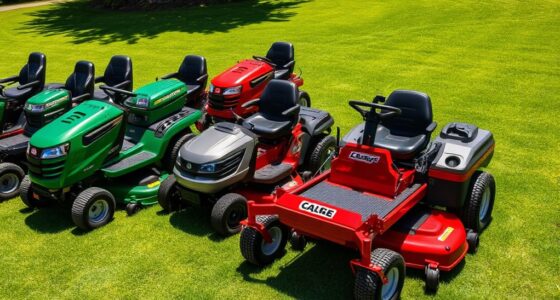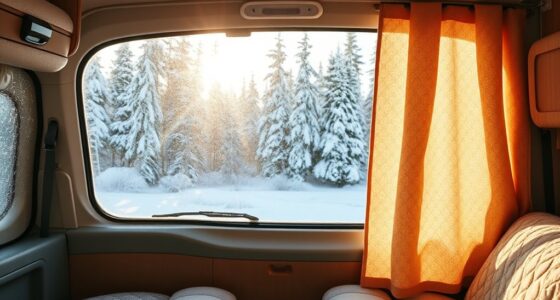If you’re looking for reliable emergency home heating options without power, I recommend kerosene heaters, propane radiant heaters, and versatile units like the VESTA self-powered heater or 2-in-1 kerosene stove. These devices provide safe, portable warmth, often with long runtimes and safety features like tip-over switches. Proper ventilation and fuel handling are essential. Keep exploring to find the best solutions that fit your needs and guarantee safety during power outages.
Key Takeaways
- Kerosene heaters provide reliable indoor heating without electricity, with options for heating and cooking during power outages.
- Portable propane radiant heaters are effective for outdoor spaces and emergencies, offering safety features like tip-over protection.
- Multi-functional kerosene heaters can heat, cook, and boil, ideal for versatile emergency use in off-grid situations.
- Proper ventilation and safety precautions are essential when using fuel-based heaters indoors to prevent carbon monoxide buildup.
- Compact, lightweight designs with handles ensure easy transport and placement of emergency heaters in various settings.
Kerosene Heater for Indoor and Outdoor Use

Are you looking for a versatile heating solution that works both indoors and outdoors? A kerosene heater can be your reliable choice. It transforms from a cozy indoor heater to a cooking surface during the day, heating up to 15 sqm rooms at night. With a 9000 BTU top surface, it delivers consistent warmth and doubles as a cooker. Its extended burn time of 16-21 hours means less refueling, perfect for overnight use. No need for electricity—just a manual knob and a 4.5L fuel tank. Its portable design, with a stainless steel handle, makes it ideal for camping, hunting, or garage use.
Best For: anyone seeking a versatile, reliable heating and cooking solution for indoor, outdoor, camping, or emergency use.
Pros:
- Dual functionality as both heater and cooker, saving space and cost
- Extended burn time of up to 21 hours for overnight warmth without frequent refueling
- Electricity-free operation ensures reliable use during power outages and outdoor activities
Cons:
- Requires manual operation and fuel management, which may be less convenient than electric options
- Potential safety concerns if not used properly in enclosed spaces or with proper ventilation
- Limited to kerosene fuel, which may necessitate sourcing and handling combustible material
VESTA Self-Powered Camping Heater & Stove
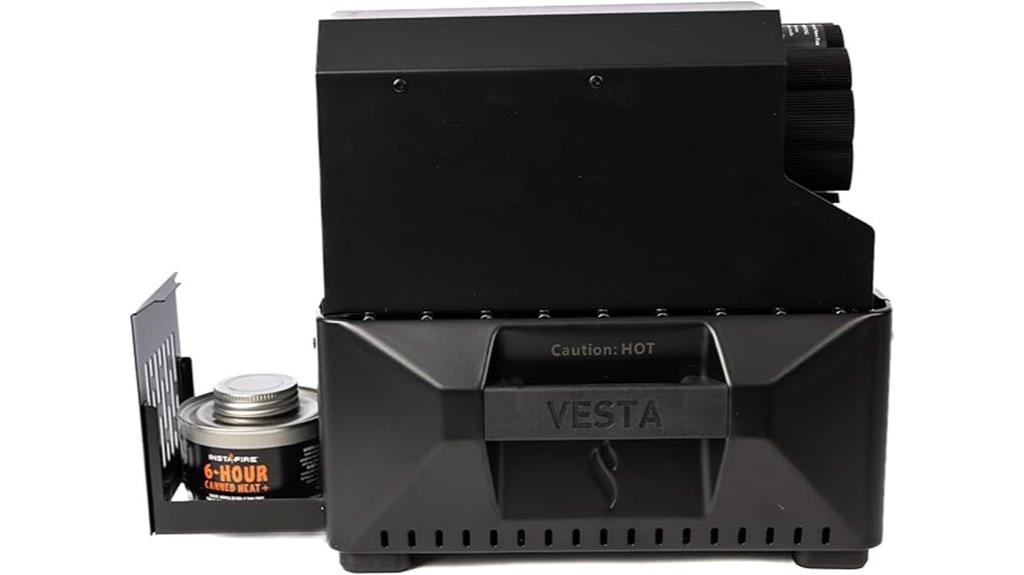
The VESTA Self-Powered Camping Heater & Stove is an excellent choice for those seeking a versatile, portable heating solution during emergencies or outdoor adventures. It combines space heating and cooking in one compact, lightweight unit, warming areas up to 200 square feet. Powered by canned heat fuel, it’s safe for indoor use without electricity and emits minimal smoke and fumes. Weighing under eight pounds, it’s easy to transport and store, making it perfect for off-grid scenarios or disaster preparedness. With included InstaFire cans, it provides immediate fuel, ensuring reliable warmth and cooking options when power is unavailable.
Best For: outdoor enthusiasts, emergency preparedness individuals, and off-grid dwellers seeking a portable, safe heating and cooking solution without electricity.
Pros:
- Combines space heating and cooking functions in one lightweight, portable unit
- Operates safely indoors using canned heat fuel with minimal smoke and fumes
- Easy to store and transport, weighing under eight pounds for convenience
Cons:
- Limited to heating areas up to 200 square feet, not suitable for large spaces
- Requires canned heat fuel, which must be purchased and stored separately
- May freeze if stored below 16°F (-8°C), potentially affecting fuel availability
2-in-1 Portable Kerosene Heater & Stove

When quick, reliable heat is essential during emergencies or outdoor activities, the 2-in-1 Portable Kerosene Heater & Stove stands out as an ideal solution. It combines heating and cooking in one compact unit, making it perfect for camping, hunting, or emergency situations. With a 9,000 BTU output and a 1.2-gallon kerosene capacity, it heats for up to 21 hours. Its portable design includes a carry handle and adjustable height, and no electricity is needed—just fill, ignite, and enjoy warmth or a hot meal. Weighing only 9.2 pounds, it’s easy to store and transport wherever you need reliable heat.
Best For: outdoor enthusiasts, campers, hunters, and homeowners needing reliable emergency heating and cooking without electricity.
Pros:
- Combines heating and cooking functions in one portable unit for versatile use.
- No electricity required, making it ideal for outdoor activities and emergency situations.
- Long-lasting heater with up to 21 hours of heat from a single kerosene fill.
Cons:
- Relatively heavy at 9.2 pounds, which may be less convenient for frequent transport.
- Requires handling of kerosene and wicks, which may pose safety considerations and need proper maintenance.
- Limited to kerosene fuel, so availability of fuel may be a concern in some areas.
9,000 BTU Portable Buddy Radiant Propane Heater

For anyone seeking a reliable, portable heating solution during emergencies or outdoor gatherings, the 9,000 BTU Portable Buddy Radiant Propane Heater stands out. It offers 4,000 or 9,000 BTU/hr radiant heat, covering about 225 square feet—perfect for indoor or outdoor use. Lightweight at just 7.1 pounds, it connects easily to 1-lb propane cylinders or 20-lb tanks. With safety features like an oxygen depletion sensor, thermal shut-down, and tip-over protection, it’s designed for safe operation. Two heat settings and up to 5.4 hours of runtime make it versatile for camping, deck parties, or emergency heating when power’s out.
Best For: campers, outdoor entertainers, and homeowners needing a portable, safe heating option for indoor or outdoor spaces during emergencies or gatherings.
Pros:
- Lightweight and portable at only 7.1 pounds for easy transportation and setup
- Provides reliable radiant heat up to 9,000 BTU/hr, effectively warming about 225 sq ft
- Equipped with multiple safety features including oxygen depletion sensor, thermal shut-down, and tip-over protection
Cons:
- Runs on propane, so continuous refilling or tank management is necessary
- Limited to about 5.4 hours of run time on a 1-lb propane cylinder before needing a refill
- Not suitable for use in enclosed spaces without proper ventilation despite safety features
11,500 BTU Kerosene Heater for Indoor Use

Looking for a reliable backup heat source during power outages or winter emergencies? The 11,500 BTU Kerosene Heater for indoor use is a fantastic option. It’s portable, non-electric, and heats efficiently up to 500 sq ft, making it perfect for garages, living rooms, or cabins. With a 1.4-gallon tank, it delivers up to 20 hours of continuous warmth. Its adjustable height and safety features, including a protective net and anti-tip base, ensure safe operation. Plus, the flat top allows for boiling water or light cooking. Lightweight and easy to set up, it’s a dependable choice for emergency preparedness.
Best For: those seeking a portable, reliable backup heating solution for indoor spaces during power outages, winter emergencies, or outdoor activities like camping and outdoor gatherings.
Pros:
- Efficiently heats up to 500 sq ft with 11,500 BTU output, ideal for various indoor environments.
- No electricity required, making it perfect for use during power outages or in off-grid locations.
- Comes with a complete accessory set, including a funnel, siphon pump, gloves, and extra wicks, for easy operation and maintenance.
Cons:
- Weighs approximately 12.23 pounds, which may be less portable for some users.
- Customer ratings are moderate at 3.6 out of 5 stars, indicating mixed reviews on performance or durability.
- Requires handling and storage of kerosene fuel, which may pose safety or odor concerns for some users.
Portable Propane Heater for Camping, Outdoor Small Space Patio Garage Heaters

A portable propane heater is an excellent emergency home heating option for outdoor enthusiasts and those facing power outages, thanks to its compact design and reliable warmth. It delivers 3,800 BTUs, heating up to 200 sq ft with rapid, consistent heat. Its self-ignition and adjustable control knob make setup simple and customizable. Lightweight, foldable, and equipped with a stable base, it’s perfect for outdoor camping, garages, patios, or tents. Rust-resistant and durable, it withstands harsh conditions like wind and cold. Compatible with 1lb propane tanks, it offers long-lasting warmth and safety, making it a versatile, practical choice for outdoor and emergency heating needs.
Best For: outdoor enthusiasts, campers, and homeowners seeking a reliable, portable heating solution for small spaces and emergency situations.
Pros:
- Provides rapid, consistent warmth up to 200 sq ft with 3,800 BTUs
- Easy to set up with self-ignition and adjustable heat control
- Durable, rust-resistant construction suitable for harsh outdoor conditions
Cons:
- Requires 1lb propane tanks (not included), which may need frequent replacement for prolonged use
- Limited heating area, best suited for small spaces only
- No built-in temperature display or digital controls
10,000 BTU Kerosene Heater for Indoor Use

When power outages strike or immediate warmth is needed, a 10,000 BTU kerosene heater proves to be a reliable indoor heating solution. It’s portable, doesn’t require electricity, and combines a stove with a heater, making it versatile for indoor and outdoor use. With an 8,000–10,000 BTU output, it effectively heats spaces up to 350 square feet. Its 1.35-gallon tank provides 15-21 hours of continuous warmth. Safety features like a safety net, sturdy base, and fuel gauge guarantee peace of mind. Plus, it includes accessories like a storage bag and a top surface for heating food, making it a practical emergency heat source.
Best For: individuals seeking a reliable, portable, and cost-effective heating solution for indoor spaces, emergencies, or outdoor activities like camping and outdoor gatherings.
Pros:
- No electricity needed, ensuring operation during power outages or in off-grid locations.
- Long runtime of up to 21 hours per fill, providing consistent warmth.
- Versatile use as both a heater and stove with included accessories for convenience.
Cons:
- Requires kerosene fuel, which may be less convenient or more costly than electric options.
- Heavier and bulkier compared to electric heaters, potentially less portable for some users.
- Safety precautions are essential due to open flame and combustible fuel, requiring careful handling.
Emergency Blanket 4-Pack Mylar Survival Blankets

Emergency Blanket 4-Pack Mylar Survival Blankets are an excellent choice for anyone needing reliable, portable warmth in emergency situations. Made from advanced aluminized Mylar, they reflect up to 90% of body heat, keeping you warm even in extreme conditions. These tear-resistant, durable blankets are reusable and versatile—they can serve as ground covers, shelters, or windbreaks. Compact and lightweight, each blanket folds down small for easy storage in your emergency kit, backpack, or glove compartment. Whether camping, hiking, or facing a natural disaster, these blankets are essential for maintaining warmth and safety when power isn’t an option.
Best For: outdoor enthusiasts, emergency preparedness kits, and anyone seeking reliable portable warmth in survival situations.
Pros:
- Reflects up to 90% of body heat, providing excellent insulation in emergencies
- Made from tear-resistant, durable Mylar for repeated use and long-term reliability
- Compact, lightweight design easily fits into backpacks, glove compartments, or emergency kits
Cons:
- May feel crinkly or uncomfortable when wrapped directly against the skin for extended periods
- Limited coverage if only a few blankets are used, requiring multiple for larger groups
- Not a substitute for proper shelter or comprehensive emergency gear in extreme conditions
Indoor & Outdoor Kerosene Heater with 3 Wicks, 9000 BTU
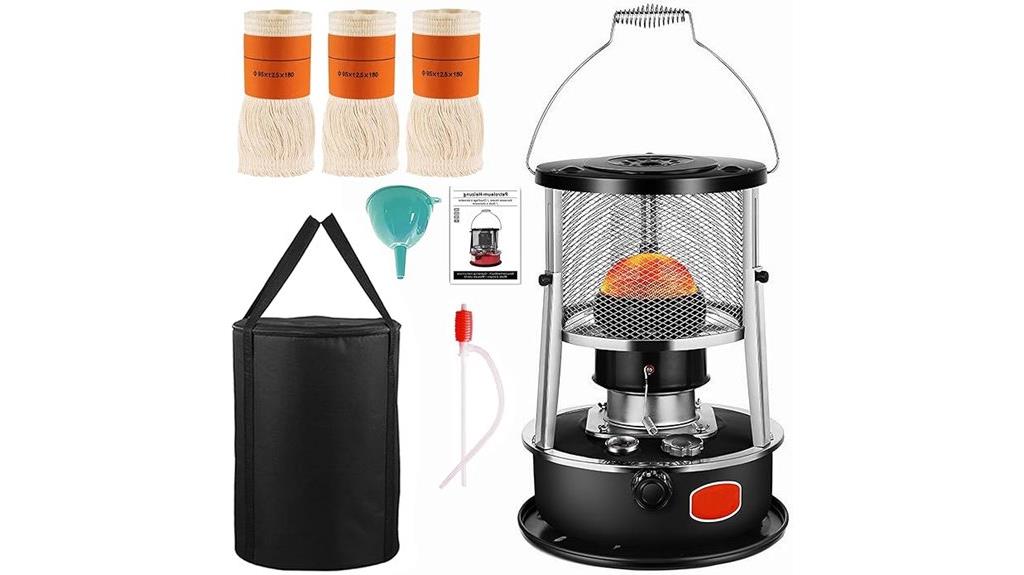
This kerosene heater is a versatile choice for anyone needing reliable warmth without relying on electricity. It’s portable, with a storage bag, making it perfect for camping, emergencies, or outdoor activities. With 9000 BTU and three wicks, it heats up to 20 square meters quickly and efficiently, burning just 0.25L of kerosene per hour. Its 360° radiant design ensures even heat distribution, with no blind spots. Made from sturdy metal, it’s smokeless, quiet, and safe, with features like anti-dumping and adjustable wind shields. Easy to operate and maintain, it’s an excellent solution for keeping warm in any situation.
Best For: outdoor enthusiasts, emergency preparedness individuals, and anyone seeking a portable, electricity-free heating solution for indoor and outdoor use.
Pros:
- Highly efficient with 99.8% combustion efficiency and quick heating up to 20 square meters
- Portable design with a storage bag, lightweight (less than 7.5 lbs), and sturdy metal construction
- Safe and smokeless operation with features like anti-dumping, adjustable wind shields, and no electricity required
Cons:
- Burns kerosene, which may emit odors or require proper ventilation during prolonged use
- Limited to 0.25L kerosene per hour, requiring regular refueling for extended use
- Needs careful handling of fuel and maintenance to ensure safety and optimal performance
Kerosene Heater for Indoor and Outdoor Use (4.5L, Red)
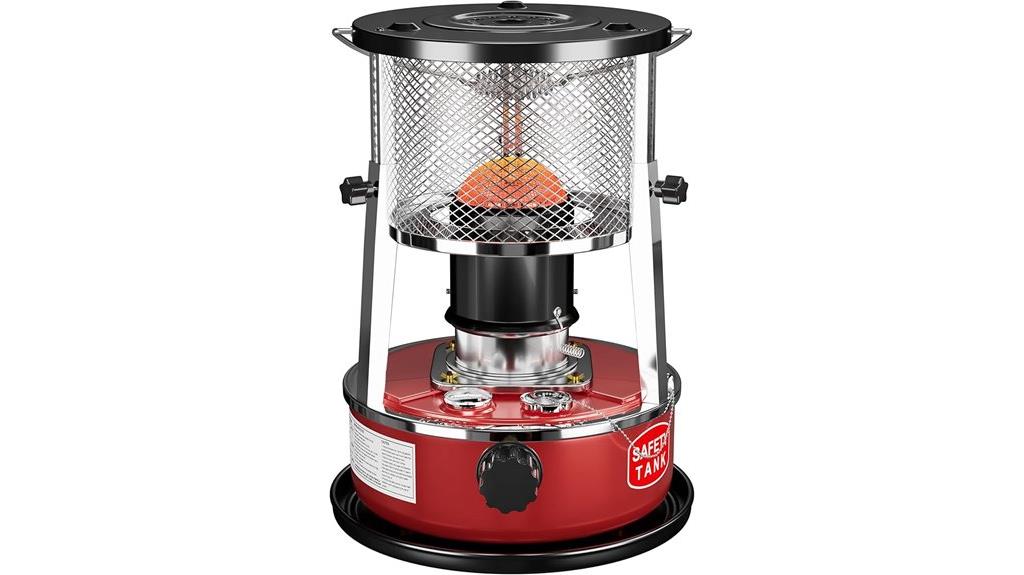
If you’re looking for a reliable heating solution that requires no electricity, the Kerosene Heater for Indoor and Outdoor Use (4.5L, Red) is an excellent choice. It provides 9000 BTU of heat, efficiently warming 20-30 square meters with 360° heat distribution. Its portable design, with a handle and adjustable height hood, makes it perfect for camping, emergencies, or outdoor activities. The heater features a flame adjuster, sealed fuel cap, safety grills, and a fuel gauge for safe operation. Quiet, energy-efficient, and eco-friendly, it can also be used for cooking, boiling, and barbecuing, making it versatile for various situations.
Best For: outdoor enthusiasts, campers, and emergency preparedness individuals seeking a portable, no-electricity heat source for indoor or outdoor use.
Pros:
- No electricity required, making it suitable for outdoor and emergency situations
- 360° heat distribution ensures efficient warming of large areas up to 30 sq meters
- Multifunctional use includes heating, cooking, boiling, and barbecuing for versatile outdoor activities
Cons:
- Slightly heavy at 10.65 pounds, may require effort to move frequently
- Requires handling of kerosene, which needs proper storage and safety precautions
- May produce fumes if not used in well-ventilated areas, requiring caution during indoor use
Kerosene Heater for Indoor Use (4.5L)
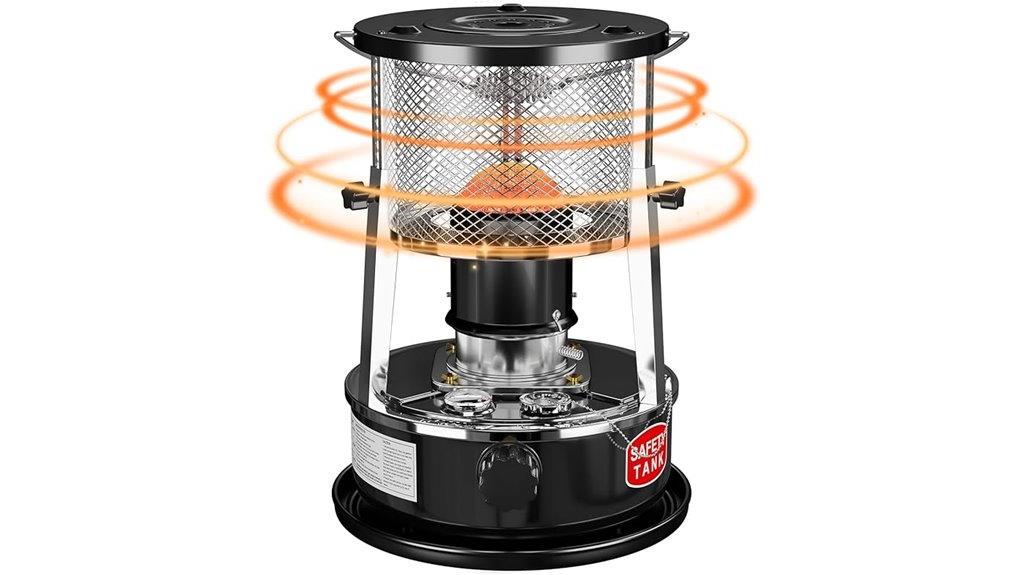
A kerosene heater with a 4.5L tank is an excellent choice for anyone needing reliable indoor warmth without electricity. It heats quickly and evenly, covering 20-30 square meters with 9000 BTU/H, enough to keep a room cozy. With a fuel consumption of just 0.2L per hour, a full tank provides 16-21 hours of continuous heat. Its compact, portable design fits well in small spaces like apartments or cabins. Safety features like a sealed fuel cap and protective grills make it easy to operate safely. Plus, its quiet, clean-burning operation makes it suitable for families, offering warmth and versatility during power outages or emergencies.
Best For: those seeking a portable, efficient, and safe indoor heating solution during cold seasons without relying on electricity.
Pros:
- Provides rapid, even heat coverage of 20-30 square meters with 9000 BTU/H
- Compact, lightweight, and equipped with a handle for easy transportation
- Safe operation with features like sealed fuel cap, protective grills, and adjustable flame control
Cons:
- Requires kerosene fuel and regular refilling for continuous use
- No built-in thermostat, so temperature control is manual
- May produce some odor or fumes, requiring adequate ventilation during use
Kerosene Heater for Indoor and Outdoor Use (4.5L, Blue)

The Kerosene Heater for Indoor and Outdoor Use (4.5L, Blue) stands out as an ideal choice for emergency situations where reliable heat is essential, especially in areas without electricity. Its portable design, lightweight handle, and no-electricity operation make it perfect for indoor, outdoor, camping, or emergency use. It heats, boils, cooks, and grills simultaneously, covering 20-30 square meters quickly with up to 9000BTU/H of heat. Safety features like grills, sealed fuel cap, and flame adjuster ensure secure use. Plus, its quiet, energy-efficient operation minimizes environmental impact, making it a versatile, reliable heating solution during power outages or outdoor adventures.
Best For: those needing portable, reliable heating solutions for indoor, outdoor, camping, or emergency scenarios without access to electricity.
Pros:
- No electricity required, ideal for power outages and off-grid use
- Multifunctional: heats, boils, cooks, and grills simultaneously
- Compact, lightweight, and portable with a handle for easy transportation
Cons:
- Fuel consumption of approximately 0.2L/hour may require frequent refueling
- Requires handling of kerosene, which needs careful storage and safety precautions
- Limited to heating areas of 20-30 square meters, not suitable for very large spaces
2-in-1 Kerosene Heater and Stove
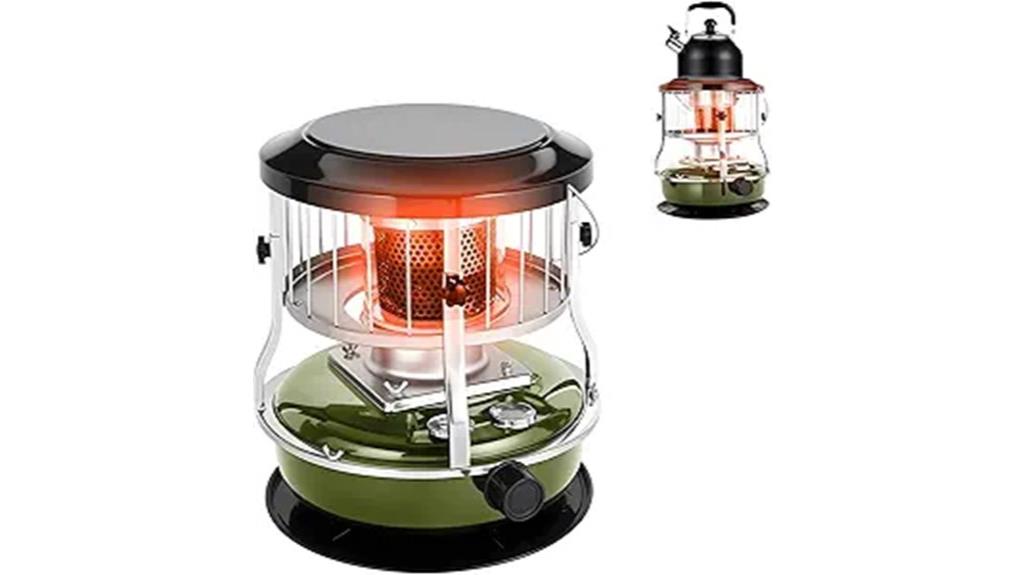
Looking for a reliable heating solution that doesn’t rely on electricity? The in-1 Kerosene Heater and Stove is perfect. It combines a kerosene heater with a stove, allowing you to heat rooms up to 15m² and cook meals or boil water during the day. With a 4.5L tank, it offers 16–21 hours of continuous, safe operation, reducing refueling needs. Its portable, adjustable design makes it ideal for indoor and outdoor use—camping, hunting, or emergencies. Delivering 9000 BTU of heat, it provides fast, even warmth with no electricity required, making it a versatile, dependable choice when power’s out.
Best For: those seeking a reliable, electricity-free heating and cooking solution for indoor or outdoor use, especially in emergencies or off-grid situations.
Pros:
- Combines heating and cooking functions in one portable device.
- Long burn time of up to 21 hours with a 4.5L fuel tank, reducing refueling needs.
- No electricity required, making it ideal for power outages and remote locations.
Cons:
- Limited to heating rooms up to 15m², not suitable for larger spaces.
- Requires kerosene fuel, which may be less convenient or available in some areas.
- Heavier and bulkier than smaller portable heaters, potentially less easy to carry.
Dyna-Glo 10K BTU Grab N Go Portable Propane Heater – Green

Need a reliable, portable heater for emergency indoor or outdoor warming? The Dyna-Glo 10K BTU Grab N Go propane heater is an excellent choice. It heats up to 250 sq. ft., making it perfect for bedrooms, home offices, or outdoor spaces. Weighing just over 10 pounds, it’s lightweight and easy to carry with its built-in handle. Powered by a standard 1 lb propane cylinder (not included), it features two adjustable heat settings, a swivel valve for quick tank changes, and CSA certification for safety. No assembly needed, and it’s suitable for both indoor and outdoor use, providing quick, efficient warmth when you need it most.
Best For: individuals seeking a portable, reliable heating solution for emergency indoor or outdoor use in small to medium-sized spaces.
Pros:
- Compact and lightweight design makes it easy to carry and transport.
- Adjustable heat settings provide customizable warmth up to 10,000 BTUs.
- CSA certification ensures safety and reliable performance.
Cons:
- Requires a separate 1 lb propane cylinder (not included), adding to overall cost.
- Limited heating coverage of approximately 250 sq. ft., not suitable for larger spaces.
- No built-in thermostat, so temperature control is manual and less precise.
Factors to Consider When Choosing Emergency Home Heating Options Without Power
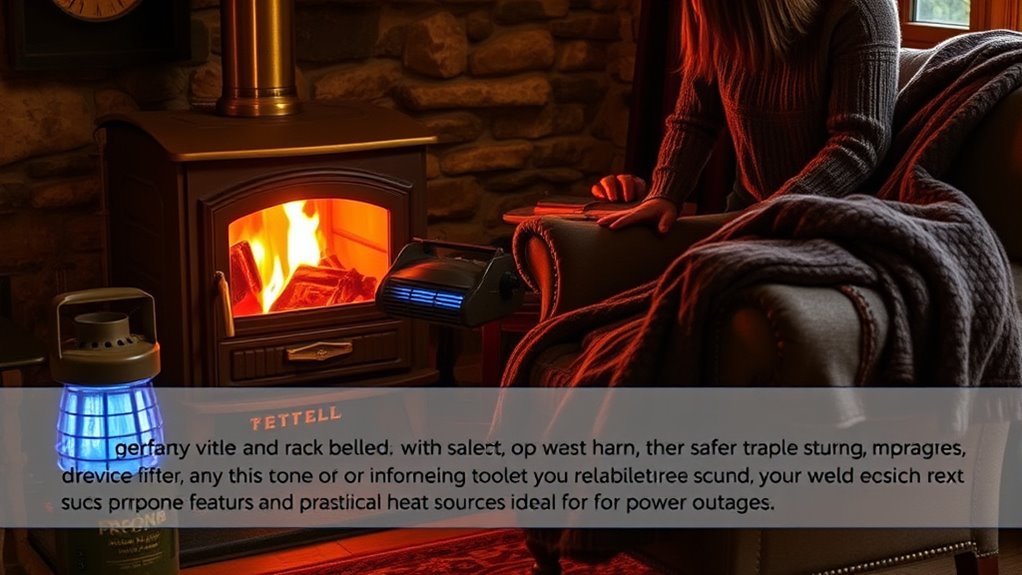
When selecting an emergency heating option without power, I consider safety first to prevent fire hazards. I also evaluate the heating capacity and fuel type to guarantee it meets my needs and fuel availability. Finally, I look at how easy it is to operate, store, and move, so I can rely on it confidently during a crisis.
Safety and Fire Risk
Choosing an emergency home heating option without power requires careful attention to safety and fire risks. I always verify any indoor heater has proper ventilation to prevent dangerous carbon monoxide buildup, which can be deadly. I look for models with safety features like tip-over switches, oxygen depletion sensors, and automatic shut-offs—they provide an extra layer of protection during emergencies. It’s also vital to keep flammable materials such as paper, cloth, or gasoline away from any heating device. Regular inspections of heater components like wicks, fuel caps, and safety grills help prevent leaks and malfunctions. Ultimately, I follow manufacturer instructions closely for installation, operation, and safety measures, reducing fire hazards and guaranteeing safe use when power is out.
Heating Capacity Needed
Selecting the right emergency heater depends largely on its heating capacity, which must match the size of the space you’re trying to warm. To do this, I recommend measuring your area in square footage. For indoor rooms between 200 and 500 square feet, a heater with 9,000 to 11,500 BTU typically provides enough warmth. Portable kerosene or propane heaters usually deliver 8,000 to 12,000 BTU, making them suitable for small to medium rooms. Keep in mind, larger spaces or open-air environments might require multiple units or higher-capacity heaters to maintain comfort. It is crucial to match the heater’s BTU output to your space to avoid overheating or wasting fuel. Proper sizing ensures efficient heating and safety during emergencies.
Fuel Type Availability
Ensuring the fuel type for your emergency heater is readily available in your area is essential for maintaining reliable heat during power outages. I recommend choosing fuels like kerosene, propane, or canned heat, which are commonly accessible in many locations. It’s important to check how long the fuel can be stored without degrading, so you’re prepared long-term. Also, consider the heater’s fuel consumption and runtime—this helps ensure your supply lasts through extended outages. Safety is key, so verify that the fuel type is safe for indoor use with minimal emissions and proper ventilation. Finally, assess how easy it is to refuel or replenish your fuel supply, especially when access to stores might be limited during a crisis. This ensures your heating remains continuous and dependable.
Portability and Storage
When preparing for power outages, the portability and storage of your emergency heater become important factors. Portable heaters typically weigh between 7 to 16 pounds, making them easy to carry and reposition as needed. Their compact designs, often with foldable handles and lightweight materials, allow for quick movement and storage during emergencies. Many units include carrying bags or cases, which improve organization and ease of transportation. Small, space-saving sizes mean they can be stored in closets, cabinets, or emergency kits without taking up much room. Additionally, heaters with adjustable height or foldable components can be stored flat or compacted, maximizing storage efficiency. Choosing a heater that’s lightweight and easy to store ensures you’re prepared without cluttering your living space.
Ease of Operation
Choosing an emergency home heater that’s easy to operate without power means prioritizing models with simple, manual controls like knobs or dials. I look for devices with straightforward start-up procedures, such as push-button ignitions or easy ignition methods, to make certain quick activation. Clear instructions and minimal setup make using the heater hassle-free during stressful situations. Safety features like automatic shut-off or tip-over switches help me operate confidently without constant attention. Additionally, I prefer lightweight, portable designs with handles or compact shapes, making repositioning simple if needed. The goal is to find a heater that’s intuitive and reliable, so I can focus on staying safe and warm without dealing with complicated controls or confusing operation steps.
Indoor Air Quality
Indoor air quality is a crucial factor to contemplate when selecting emergency heating options that don’t rely on electricity. Certain heaters, like kerosene or propane models, produce emissions and fumes that can harm indoor air if not managed carefully. Proper ventilation is essential to prevent the buildup of carbon monoxide and other pollutants, which can be dangerous or even deadly. Luckily, some heating options emit minimal smoke and fumes when used correctly with good airflow. Regular maintenance and strategic placement of heaters also help reduce indoor air contamination. I recommend using portable air quality detectors to monitor pollutants during operation, ensuring a safe environment. Prioritizing indoor air quality helps you stay safe and comfortable during power outages or emergencies.
Cost and Maintenance
Considering the costs and maintenance needs of emergency heating options can help you select a solution that’s both affordable and reliable. The initial purchase price varies widely—from budget-friendly kerosene heaters to more costly propane or wood-burning units. Regular upkeep, like cleaning wicks, fuel filters, and ensuring proper ventilation, is essential for safe and efficient operation. Fuel costs for kerosene, propane, or other combustibles can add up during prolonged outages, impacting your ongoing expenses. Some heaters require minimal maintenance, while others need routine inspections and part replacements to prevent safety hazards. Choosing durable, low-maintenance equipment may cost more upfront but can save you money over time by reducing repair needs and ensuring dependable performance when you need it most.
Frequently Asked Questions
How Long Do Emergency Home Heaters Typically Operate on a Full Fuel Tank?
Emergency home heaters typically operate for about 8 to 24 hours on a full fuel tank, depending on the heater’s size and fuel efficiency. I always recommend checking the specific model’s specifications, as some units can last longer or shorter. To make certain you’re prepared, keep extra fuel supplies on hand, and monitor usage closely during power outages. This way, you’ll stay warm until power is restored.
Are There Safety Risks Associated With Using Kerosene and Propane Heaters Indoors?
Using kerosene and propane heaters indoors can be risky if not handled properly. I always guarantee proper ventilation to avoid carbon monoxide buildup, which can be deadly. I also follow manufacturer instructions carefully to prevent fires or leaks. Regular maintenance and safety checks are essential. When used responsibly, these heaters can be safe, but I never underestimate the importance of caution to protect my family during emergencies.
Can Portable Heaters Be Used Safely in Small Enclosed Spaces?
Using portable heaters in small enclosed spaces is like trying to keep a campfire cozy—if you don’t watch it carefully, it can become dangerous. I always guarantee proper ventilation and follow the manufacturer’s safety instructions. It’s essential to keep flammable objects away and never leave the heater unattended. When used correctly, they can be safe, but I recommend extra caution to prevent carbon monoxide buildup or fire hazards.
What Are the Best Storage Practices for Emergency Heating Fuels?
I always store emergency heating fuels in a cool, dry, and well-ventilated area away from anything flammable. I use approved containers, clearly labeled, and keep them upright to prevent leaks. Regularly, I check for corrosion or damage and replace older fuels. Safe storage is key to prevent accidents and guarantee I have reliable heat when power’s out. Proper practices keep my family safe and prepared.
How Do I Maintain and Clean Emergency Heaters for Optimal Safety?
I make certain to regularly inspect my emergency heaters for any signs of damage or corrosion. I clean filters and vents with a soft brush and check for blockages to ensure efficient operation. I also follow the manufacturer’s instructions for maintenance, like cleaning or replacing filters and inspecting safety components. Keeping my heater in good shape not only prolongs its lifespan but also guarantees safe, reliable heat when I need it most.
Conclusion
When selecting an emergency heater, remember that around 45% of households experience power outages annually, making reliable heating indispensable. With options like kerosene and propane heaters, you can stay warm even without electricity. I’ve found that portable solutions can provide up to 11,500 BTUs, enough to keep a small space cozy. Being prepared with the right heater not only ensures comfort but also peace of mind during unexpected outages.




